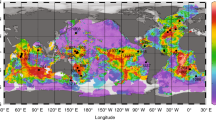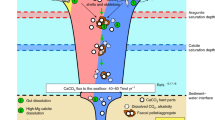Abstract
The preservation and dissolution of calcium carbonate (namely calcium carbonate pump) controls the pH of seawater in global oceans by its buffer effect, and in turn plays a significant role in global changes in atmospheric CO2 concentration. The results from measured carbonate contents over the past 2 Ma at ODP Site 1143 in the South China Sea provide high-resolution records to explore the process of the calcium carbonate pump during Quaternary glacial cycles. The results indicate statistically that the highest carbonate accumulation rate leads the lightest δ18O by about 3.6 ka at transitions from glacials to interglacials, and that the strongest carbonate dissolution lags the lightest δ18O by about 5.6 ka at transitions from interglacials to glacials. The calcium carbonate pump releases CO2 to the atmosphere at the glacial-interglacial transitions, but transports atmospheric CO2 to deep sea at the interglacial-glacial transitions. The adjustable function of the calcium carbonate pump for the deep-sea CO 2−3 concentration directly controls parts of global changes in atmospheric CO2, and contributes the global carbon cycle system during the Quaternary.
Similar content being viewed by others
References
Hays, J. D., Imbrie, J., Shackleton, N. J., Variations in the Earth’s orbit: pacemaker of the Ice Ages, Science, 1976, 194: 1121–1132.
Sigman, D. M., Boyle, E. A., Glacial/interglacial variations in atmospheric carbon dioxide, Nature, 2000, 407: 859–869.
Webb, R. S., Lehman, S. J., Rind, D. H. et al., Influence of ocean heat transport on the climate of the Last Glacial Maximum, Nature, 1997, 385: 695–699.
Petit, J. R., Jouzel, J., Raynaud, D. et al., Climate and atmospheric history of the past 420,000 years from the Vostok ice core, Antarctica, Nature, 1999, 399: 429–436.
Adams, J. M., Faure, H., Faure-Denard, L. et al., Increases in terrestrial carbon storage from the Last Glacial Maximum to the present, Nature, 1990, 348: 711–714.
Guilderson, T. P., Fairbanks, R. G., Rubenstone, J. L., Tropical temperature variations since 20000 years ago: modulating interhemispheric climate change, Science, 1994, 263: 663–665.
Broecker, W., Peng, T.-H., The role of CaCO3 compensation in the glacial to interglacial atmospheric CO2change, Glob. Biogeochem. Cycles, 1987, 1: 15–29.
McElroy, M. B., Marine geological controls on atmospheric CO2and climate, Nature, 1983, 302: 328–329.
Sarmiento, J. L., Toggweiler, J. R., A new model for the role of the oceans in determining atmospheric pCO2, Nature, 1983, 308: 621–624.
Elderfield, H., Carbonate mysteries, Science, 2002, 296: 1618–1621.
Broecker, W. S., Ocean chemistry during glacial time, Geochim. Cosmochim. Acta, 1982, 46: 1689–1706.
Anderson, R. F., Chase, Z., Fleisher, M. Q. et al., The Southern Ocean’s biological pump during the Last Glacial Maximum, Deep Sea Res. II, 2002, 49: 1909–1938.
Jansen, H., Modelling the marine carbonate pump and its implications on the atmospheric CO2concentration, Bremen: Universität Bremen (Dissertation), 2001, 1–128.
Broecker, W. S., Sanyal, A., Magnitude of the CaCO3 dissolution events making the onset of times of glaciation, Paleoceanography, 1997, 12: 530–532.
Broecker, W. S., Clark, E., Glacial-to-Holocene redistribution of carbonate ion in the deep sea, Science, 2001, 294: 2152–2155.
Anderson, D. M., Archer, D., Glacial-interglacial stability of ocean pH inferred from foraminifer dissolution rates, Nature, 2002, 416: 70–73.
Keir, R. S., Berger, W. H., Atmospheric CO2content in the last 120,000 years: the phosphate-extraction model, J. Geophys. Res., 1983, 88: 6027–6038.
Peterson, L. C., Prell, W. L., Carbonate preservation and rates of climatic change: an 800 kyr record from the Indian Ocean (eds. Sundquist, E. T., Broecker, W. S.), The Carbon Cycle and Atmospheric CO2: Natural Variations Archean to Present, Washington, D. C: AGU, Geophys. Monogr. 32, 1985, 251–269.
Wu, G., Yasuda, M. K., Berger, W. H., Late Pleistocene carbonate stratigraphy on Ontong-Java Plateau in the western equatorial Pacific, Mar. Geol., 1991, 99: 135–150.
Le, J., Shackleton, N. J., Carbonate dissolution fluctuations in the western equatorial Pacific during the Late Quaternary, Paleoceanography, 1992, 7: 21–42.
Curry, W. B., Lohmann, G. P., Late Quaternary carbonate sedimentation at the Sierra Leone Rise (eastern equatorial Atlantic Ocean), Mar. Geol., 1986, 70: 223–250.
Hodell, D. A., Charles, C. D., Sierro, F. J., Late Pleistocene evolution of the ocean’s carbonate system, Earth Planet. Sci. Lett., 2001, 192: 109–124.
Sanyal, A., Hemming, N. G., Hanson, G. N. et al., Evidence for a higher pH in the glacial ocean from boron isotopes in foraminifera, Nature, 1995, 373: 234–236.
Wang, H., Jain, Z., Carbonate dilution cycles in the late Quaternary South China Sea (eds. Ye, Z., Wang, P.), Contributions to Late Quaternary Paleoceanography of the South China Sea (in Chinese with English abstract), Qingdao: Qingdao Ocean Univ. Press, 1992, 283–294.
Wang, P., Prell, W. L., Blum, P. et al., Proceedings of the ODP, Initial Reports 184, College Station: Ocean Drilling Program, Texas A&M University, 2000, 1–103 [CD-ROM].
Rottmann, M. L., Dissolution of planktonic foraminifera and pteropods in South China Sea sediments, J. Foraminiferal Res., 1979, 9: 41–49.
Miao, Q. R., Thunell, C., Anderson, D. M., Glacial-Holocene carbonate dissolution and sea surface temperatures in the South China and Sulu seas, Paleoceanography, 1994, 9: 269–290.
Hanebuth, T., Stattegger, K., Grootes, P. M., Rapid flooding of the Sunda Shelf: A late-glacial sea-level record, Science, 2000, 288: 1033–1035.
Thunell, R. C., Miao, Q., Calvert, S. E. et al., Glacial-Holocene biogenic sedimentation patterns in the South China Sea: Productivity variations and surface water pCO2, Paleoceanography, 1992, 7: 143–162.
Wang, P., Tian, J., Cheng, X., Transition of Quaternary glacial cyclicity in deep-sea records at Nansha, the South China Sea, Science in China, Ser. D, 2001, 44(10): 926–933.
Shackleton, N. J., Berger, A., Peltier, W. R., An alternative astronomical calibration of the lower Pleistocene timescale based on ODP Site 677, Transactions of the Royal Society of Edinburgh: Earth Sciences, 1990, 81: 251–261.
Tian, J., Wang, P., Cheng, X. et al., Astronomically tuned Plio-Pleistocene benthic δ18O record from South China Sea and Atlantic-Pacific comparison, Earth Planet. Sci. Lett., 2002, 203: 1015–1029.
Jones, A., Kaiteris, P., A vacuum gasometic technique for rapid and precise analysis of calcium carbonate in sediments and soils, J. Sediment. Petrol., 1983, 53: 655–660.
Howard, W. R., Prell, W. L., Late Quaternary CaCO3 production and preservation in the Southern Ocean: Implications for oceanic and atmospheric carbon cycling, Paleoceanography, 1994, 9: 453–482.
Howell, P., ARAND time series and spectral analysis package for the Macintosh, Brown University, IGBP PAGES/World Data Center for Paleoclimatology Data Contribution Series #2001-044, Boulder, Colorado, USA: NOAA/NGDC Paleoclimatology Program, 2001.
Imbrie, J., Hays, J. D., Martinson, D. G. et al., The ordital theory of Pleistocene climate: A support from a revised chronology of the marine δ18O record (eds. Berger, A., Imbrie, J.), Milankovitch and Climate, Mass: Hingham, 1984, 269–305.
Ruddman, W. F., Pleistocene sedimentation in the equatorial Atlantic: Stratigraphy and faunal paleoclimatology, Bull. Geol. Soc. Am., 1971, 82: 283–302.
Wang, P., Min, Q., Bian, Y. et al., Planktonic foraminifera in the continental slope of the northern South China Sea during the last 130,000 years and their paleoceanographic implications, Acta Geol. Sin. (in Chinese and English abstract), 1986, 60: 215–225.
Wang, P., Wang, L., Bian, Y. et al., Late Quaternary paleoceanography of the South China Sea: surface circulation and carbonate cycles, Mar. Geol., 1995, 127: 145–165.
Fischer, H., Wahlen, M., Smith, J. et al., Ice cope records of atmospheric CO2around the last three glacial terminations, Science, 1999, 283: 1712–1714.
Author information
Authors and Affiliations
Corresponding author
About this article
Cite this article
Liu, Z., Xu, J., Tian, J. et al. Calcium carbonate pump during Quaternary glacial cycles in the South China Sea. Chin.Sci.Bull. 48, 1862–1869 (2003). https://doi.org/10.1007/BF03184069
Received:
Accepted:
Issue Date:
DOI: https://doi.org/10.1007/BF03184069




